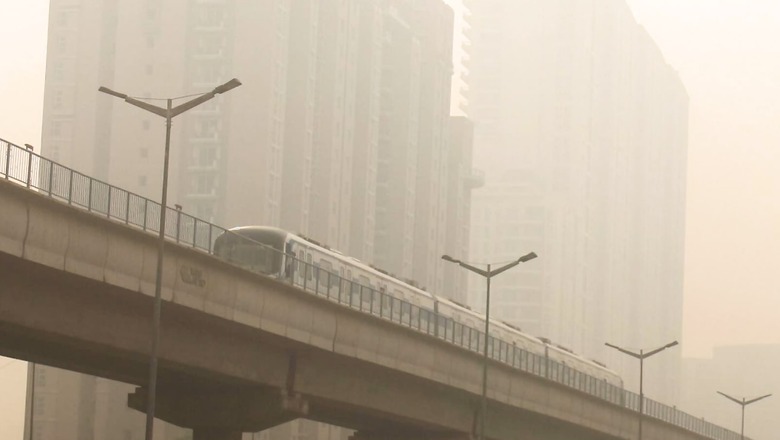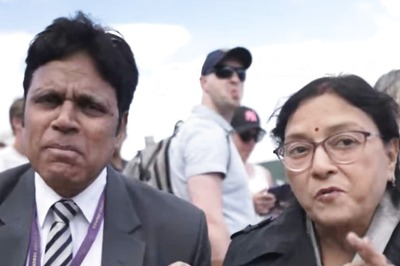
views
We forget death very easily. COVID-19 killed a little more than 25,000 residents of Delhi over the last 18 months. Strict lockdowns were enforced, life came to a standstill and there was genuine anguish among policymakers and voters. However, everything is almost back to normal and all is forgiven and forgotten. The anxiety should have shifted to pollution even as Delhi has been recording dangerous air quality that is fatal for the elderly and those predisposed to lung problems and heart diseases. If 25,000 died due to COVID-19 in the last 18 months, Delhi recorded 54,000 deaths because of pollution only in 2020. India contributes nearly a third of worldwide premature deaths due to poor air quality.
If death does not impact us, let us look at the economic losses we incur due to pollution. A study published in The Lancet found that 1.67 million deaths were attributed to air pollution in India in 2019. Another Harvard study pointed out that 2.5 million Indians died in 2018 due to fossil fuel pollution. How much do we lose because of these premature deaths of productive human beings every year? How much does our creaking healthcare system spend on treating the morbidity due to pollution? How much does labour productivity fall when people are coughing and wheezing at their workplace?
It is widely estimated that the economic cost of air pollution in India accounts for 4.5 per cent of the GDP, where premature mortality contributes to half the burden and health costs account for the rest. This is such an understatement; what these calculations do not include is the loss of productivity due to polluted air. There are several studies that show that when ambient pollution levels are high, worker productivity is low. The impact on the GDP is obvious, as not only does production suffer but so will consumption. A Greenpeace estimate puts the economic cost for Delhi alone at 13 per cent of the state domestic product, amounting to nearly USD 8 billion last year.
There are two different ways of measuring this loss. The numbers we see are those that calculate the impact based on human resource losses. These numbers, however, go up when the willingness to pay method is used. This is when the calculations take into account the maximum price residents are willing to pay to reduce the pollution levels. When Beijing was seized with the same problem as Delhi is today, nearly 20 years ago, the estimates for human resource cost versus the willingness to pay were at 3 per cent and 6 per cent of the Chinese GDP, respectively. If the willingness to pay were to be taken into account for Delhi, the national capital is losing more than Rs 1 lakh crore every year, or an estimated USD 13 billion worth of productivity due to the dangerous ambient air quality.
The COVID analogy is indeed illustrative here. Seized with an unknown and dangerous virus, the government had announced a stimulus package of Rs 20 lakh crore. With many more deaths due to air pollution, and a far bigger economic cost for Delhi and entire North India, the lack of attention of inexplicable.
India today is faced with a clear and present danger. Our coal consumption has quadrupled in the last eight years as energy consumption has gone up. The resultant air pollution is killing our citizens in our cities. We have much to learn from China, when it opened up its industry to private and global players two decades before us and hurtled towards massive energy use and private transport. Beijing became the most polluted city in the world and thousands died year after year. In the late nineties, however, the social costs and more vividly the economic costs became apparent and subsequently a massive drive was undertaken to tackle the menace.
Delhi must learn from the mistakes of Beijing. The national capital is a rich city with very high per capita income. There is bound to be a large willingness to pay to avoid respiratory troubles and death. All the causes of the pollution can be tackled rather easily. Farmers in Punjab and Haryana must be paid to buy equipment they need to clear their stubble and get ready for the next crop. This will not cost more than an estimated USD 500 million. Inside homes, we need better stoves, not those that run on kerosene or firewood. To provide clean fuel to the slum populations in Delhi, the city would need another USD 100 million. These one time costs, at less than a billion dollars, are miniscule compared to the USD 8 billion Delhi loses every year.
What we need is public uproar, and an articulation of the anxiety that we saw during COVID-19. That is when Delhi, like Beijing, will take strong steps and spend the monies to bring air quality back to safe and normal levels.
Amir Ullah Khan is Research Director, Centre for Development Policy and Practice. The views expressed in this article are those of the author and do not represent the stand of this publication.
Read all the Latest Opinions here




















Comments
0 comment